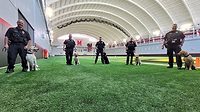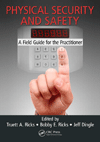Better together: Humans and tech scale physical security capabilities

Image via Unsplash
Private security staff help protect communities, businesses, public services, events, VIPs, residences and infrastructure. And the need is growing. Global spending on private security is projected to double from $241B in 2016 to $496B in 2028. In the United States, more than 1.2 million individuals work as security guards; globally, nearly 7.9 million do.
However, there’s a significant shortage of these trained professionals, and it’s unlikely to get better. Precise information is hard to come by, but many companies say they’re unable to hire as many professionals as they need and are experiencing 100%-300% turnover yearly, meaning there is no opportunity to get ahead of the curve. While salaries certainly play a factor in retaining staff, employees may also feel unsafe and depart for jobs in less risky industries, such as e-commerce or food service.
Physical security companies can use technology to augment human capabilities, helping meet the rising need for talent, skills and services. Technology can help scale the capabilities of small teams, minimize the risks security guards encounter on the job and empower them to do their jobs more efficiently and effectively. It could also help security companies attract and retain staff, as employees feel more protected as they work and can defend themselves against unwarranted accusations.
Physical security companies that may have paused IT investments should rest assured that hardware is no longer as expensive as it once was, due to fast-paced development, market competition, global supply chains, and innovative SaaS pricing models. Meanwhile, software can help drive recurring revenue, providing rapid ROI and boosting margins.
Capabilities every physical security company should have
If they haven’t already, security company leaders will want to consider:
Equipping guards with body cameras
Widely used by police forces, body cameras provide high-definition video and audio footage, even in low-light conditions, such as in dark buildings. They’re also being adopted by security companies and industry firms, such as retailers, experiencing more conflictual encounters with the public. Employees wearing body cameras are more accountable for their actions, which they know are being recorded. Body cameras also help de-escalate conflicts, as would-be aggressors know their footage can be used for criminal cases. They further help prevent or end lawsuits, as a visual audit trail with time and date stamping and an audio narrative vanquish spurious claims.
Deploying AI-powered surveillance
It may not always be practical to deploy human talent for monitoring and surveillance. For example, organizations with large campuses or remote locations may not be able to field a full security field force — or want to. Commercial development projects may require protection but may not provide the needed infrastructure for on-site staff. And at concerts or sporting events, a small team may be responsible for the safety of tens of thousands. AI-powered surveillance capabilities can expand security’s reach. These systems apply image recognition and computer vision to video feeds from stationary cameras, such as unauthorized intrusions, suspicious behavior or other incidents. With these capabilities, lean teams can focus on the highest risks and threats while leaving routine monitoring to technology.
Integrating hardware and software
Integrated hardware and software enable security companies to gain the best new features as functionality and upgrades are rolled out over the air. SaaS-like upgrades also extend hardware lifespans, improving their ROI.
Replacing and augmenting human roles
Extending human talent may not always be an option if companies can’t hire enough staff, maintain continuity across shifts and accounts or work in extremely high-risk areas. In these instances, replacing humans with technology may be the best option. Security companies are:
Deploying drones and robots
Drones provide an eye in the sky, patrolling airspace over facilities, which can be invaluable for military installations, remote physical infrastructure such as oil rigs, and companies with valuable intellectual property or those that support national security missions. Drones with thermal imaging cameras can patrol large areas and detect intruders in poor-visibility conditions, such as at night. Teams monitoring their feeds can then direct security teams to the affected areas with pinpoint precision.
Enabling remote monitoring and control
Many organizations operate valuable unmanned physical infrastructure, such as utility substations, telecommunication cable stations, bridges and more. Leaders may want to protect these assets but not deploy local security forces. They can leverage 24/7 AI-powered monitoring services. For example, at utility substations, remote monitoring extends access controls and searches for unauthorized intruders; it rapidly detects emergency conditions such as smoke, fire, arcing or potential overheating events, alerting first responders.
Navigating ethical and legal considerations
As security companies adopt more technology, they must consider ethical and legal considerations. Technology such as body cameras, drones, and robots capture and store real-time, extended video and audio footage of individuals, crowds, and actions in various locations. While individuals at large-scale public venues and events likely expect to be monitored, individuals working on the job or residing in communities may not.
Addressing privacy concerns
Organizations using security technology should consider placing public notices that sites are under surveillance and caution that individuals entering accept those conditions. If securing private areas, leaders will likely want to communicate in writing with residents and other community members. These communiques should include how technology is used and how video and audio footage is stored, accessed and secured.
Data auditability
Technology should be kept in good working order, providing clear video and audio feeds and date and time stamps. Leaders will want to define video monitoring and archive policies, such as whether humans and AI or only AI review footage and how long footage is stored. Security companies serving high-conflict or litigious industries will want to preserve footage longer for court cases, while those in residential areas may delete footage within 30 days.
Working together to protect communities and businesses
Technology can free security teams from the drudgery of foot patrols while directing their talents to issues that do need investigation. Similarly, technology can help small teams make a bigger impact. And as legal risks and threats grow, videotaping events can often be the best defense: helping defray tense situations and reminding all parties involved that there is a true record of what transpired.
Looking for a reprint of this article?
From high-res PDFs to custom plaques, order your copy today!









